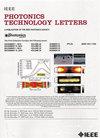Frequency-Dependent Variations in DAC ENoB: Predicting Accurate High-Speed Eye-Diagrams
IF 2.5
3区 工程技术
Q2 ENGINEERING, ELECTRICAL & ELECTRONIC
引用次数: 0
Abstract
While previous digital-to-analog converter (DAC) simulation models predict frequency-dependent effective number of bits (ENoB) well, the time domain distortions are exaggerated. We introduce a model preserving ENoB accuracy and it improves the treatment of time-domain behavior. We enhance model accuracy by filtering out spurious frequency content from aliasing and distortion that mask true behavior. We validate frequency-dependent ENoB for three commercial DACs by comparing our model output to known performance. We run a back-to-back electrical experiment to assess the accuracy of the model to predict bit error rate (BER) for baud rates from 70 to 120 Gbaud. We show that, unlike our model, the previous model leads to predictions of eye-opening and BER that are overly pessimistic at higher baud rates. We analyze the influence of oversampling, showcasing the trade-offs between the accuracy of the expected ENoB and the computational complexity. This work provides a comprehensive tool for understanding the constraints imposed by DACs, facilitating the optimization of next-generation optical communication systems.DAC ENoB的频率相关变化:预测准确的高速眼图
虽然以前的数模转换器(DAC)仿真模型可以很好地预测频率相关的有效位数(ENoB),但时域失真被夸大了。我们引入了一个保持ENoB精度的模型,改进了对时域行为的处理。我们通过从混叠和失真中过滤掉掩盖真实行为的虚假频率内容来提高模型精度。通过将我们的模型输出与已知性能进行比较,我们验证了三个商用dac的频率相关ENoB。我们进行了一个背靠背的电气实验,以评估模型预测波特率从70到120 Gbaud的误码率(BER)的准确性。我们表明,与我们的模型不同,之前的模型在较高的波特率下导致大开眼界和误码率的预测过于悲观。我们分析了过采样的影响,展示了期望ENoB的准确性和计算复杂性之间的权衡。这项工作为理解dac所施加的限制提供了一个全面的工具,促进了下一代光通信系统的优化。
本文章由计算机程序翻译,如有差异,请以英文原文为准。
求助全文
约1分钟内获得全文
求助全文
来源期刊

IEEE Photonics Technology Letters
工程技术-工程:电子与电气
CiteScore
5.00
自引率
3.80%
发文量
404
审稿时长
2.0 months
期刊介绍:
IEEE Photonics Technology Letters addresses all aspects of the IEEE Photonics Society Constitutional Field of Interest with emphasis on photonic/lightwave components and applications, laser physics and systems and laser/electro-optics technology. Examples of subject areas for the above areas of concentration are integrated optic and optoelectronic devices, high-power laser arrays (e.g. diode, CO2), free electron lasers, solid, state lasers, laser materials'' interactions and femtosecond laser techniques. The letters journal publishes engineering, applied physics and physics oriented papers. Emphasis is on rapid publication of timely manuscripts. A goal is to provide a focal point of quality engineering-oriented papers in the electro-optics field not found in other rapid-publication journals.
 求助内容:
求助内容: 应助结果提醒方式:
应助结果提醒方式:


